Integrating BSA-Seq with RNA-Seq Reveals a Novel Fasciated Ear5 Mutant in Maize
Abstract
1. Introduction
2. Results
2.1. Phenotypic Analysis of The fea5 Mutant
2.2. The fea5 Mutant Exhibits an Enlarged and Flattened Inflorescence Meristem
2.3. Whole-Genome Sequencing and BSA-Seq Analysis
2.4. Transcriptome Profiling of the fea5 Mutant
2.5. DEGs Involved in Phytohormone Signal Transduction Are Enriched
2.6. Phytohormones Measurement
2.7. Identification of the Candidate Genes Related to fea5
2.8. Natural Variations in Zm00001d048841 Are Associated with KRN in Maize
3. Discussion
3.1. The Combination of BSA-Seq and RNA-Seq Is an Effective Strategy for Gene Fine Mapping
3.2. DEGs Involved in Phytohormone Pathways May Play Major Roles in the Development of Fasciated Ears in Maize
3.3. Phospholipase Activity Is Involved in IAA-Stimulated Cell Division and Growth
4. Materials and Methods
4.1. Experiment Population
4.2. Scanning Electron Microscopy (SEM)
4.3. DNA Library Construction and BSA-Seq Analysis
4.4. RNA-Sequencing (RNA-Seq) Analysis
4.5. Plant Hormone Quantification
4.6. Gene Expression Analysis
4.7. Statistical Analyses
5. Conclusions
Supplementary Materials
Author Contributions
Funding
Institutional Review Board Statement
Informed Consent Statement
Data Availability Statement
Acknowledgments
Conflicts of Interest
References
- Yang, N.; Xu, X.W.; Wang, R.R.; Peng, W.L.; Cai, L.; Song, J.M.; Li, W.; Luo, X.; Niu, L.; Wang, Y.; et al. Contributions of Zea mays subspecies mexicana haplotypes to modern maize. Nat. Commun. 2017, 8, 1874. [Google Scholar] [CrossRef]
- Upadyayula, N.; da Silva, H.S.; Bohn, M.O.; Rocheford, T.R. Genetic and QTL analysis of maize tassel and ear inflorescence architecture. Theor. Appl. Genet. 2006, 112, 592–606. [Google Scholar] [CrossRef]
- Doebley, J. The genetics of maize evolution. Annu. Rev. Genet. 2004, 38, 37–59. [Google Scholar] [CrossRef]
- Vollbrecht, E.; Schmidt, R.J. Development of the inflorescences. In Handbook of Maize: Its Biology; Bennetzen, J.L., Hake, S., Eds.; Springer: New York, NY, USA, 2009; pp. 13–40. [Google Scholar]
- Williams, L.; Fletcher, J.C. Stem cell regulation in the Arabidopsis shoot apical meristem. Curr. Opin. Plant Biol. 2005, 8, 582–586. [Google Scholar] [CrossRef] [PubMed]
- Somssich, M.; Je, B.I.; Simon, R.; Jackson, D. CLAVATA-WUSCHEL signaling in the shoot meristem. Development 2016, 143, 3238–3248. [Google Scholar] [CrossRef]
- Bommert, P.; Lunde, C.; Nardmann, J.; Vollbrecht, E.; Running, M.; Jackson, D.; Hake, S.; Werr, W. thick tassel dwarf1 encodes a putative maize ortholog of the Arabidopsis CLAVATA1 leucine-rich repeat receptor-like kinase. Development 2005, 132, 1235–1245. [Google Scholar] [CrossRef] [PubMed]
- Bommert, P.; Nagasawa, N.S.; Jackson, D. Quantitative variation in maize kernel row number is controlled by the FASCIATED EAR2 locus. Nat. Genet. 2013, 45, 334–337. [Google Scholar] [CrossRef] [PubMed]
- Je, B.I.; Gruel, J.; Lee, Y.K.; Bommert, P.; Arevalo, E.D.; Eveland, A.L.; Wu, Q.; Goldshmidt, A.; Meeley, R.; Bartlett, M.; et al. Signaling from maize organ primordia via FASCIATED EAR3 regulates stem cell proliferation and yield traits. Nat. Genet. 2016, 48, 785–791. [Google Scholar] [CrossRef] [PubMed]
- Vollbrecht, E.; Springer, P.S.; Goh, L.; Buckler, E.S.; Martienssen, R. Architecture of floral branch systems in maize and related grasses. Nature 2005, 436, 1119–1126. [Google Scholar] [CrossRef]
- Bortiri, E.; Chuck, G.; Vollbrecht, E.; Rocheford, T.; Martienssen, R.; Hake, S. ramosa2 encodes a LATERAL ORGAN BOUNDARY domain protein that determines the fate of stem cells in branch meristems of maize. Plant Cell 2006, 18, 574–585. [Google Scholar] [CrossRef]
- Satoh-Nagasawa, N.; Nagasawa, N.; Malcomber, S.; Sakai, H.; Jackson, D. A trehalose metabolic enzyme controls inflorescence architecture in maize. Nature 2006, 441, 227–230. [Google Scholar] [CrossRef] [PubMed]
- Phillips, K.A.; Skirpan, A.L.; Liu, X.; Christensen, A.; Slewinski, T.L.; Hudson, C.; Barazesh, S.; Cohen, J.D.; Malcomber, S.; McSteen, P. vanishing tassel2 encodes a grass-specific tryptophan aminotransferase required for vegetative and reproductive development in maize. Plant Cell 2011, 23, 550–566. [Google Scholar] [CrossRef] [PubMed]
- Gallavotti, A.; Barazesh, S.; Malcomber, S.; Hall, D.; Jackson, D.; Schmidt, R.J.; McSteen, P. sparse inflorescence1 encodes a monocot-specific YUCCA-like gene required for vegetative and reproductive development in maize. Proc. Natl. Acad. Sci. USA 2008, 105, 15196–15201. [Google Scholar] [CrossRef] [PubMed]
- Galli, M.; Liu, Q.; Moss, B.L.; Malcomber, S.; Li, W.; Gaines, C.; Federici, S.; Roshkovan, J.; Meeley, R.; Nemhauser, J.L.; et al. Auxin signaling modules regulate maize inflorescence architecture. Proc. Natl. Acad. Sci. USA 2015, 112, 13372–13377. [Google Scholar] [CrossRef] [PubMed]
- Bolduc, N.; Hake, S. The maize transcription factor KNOTTED1 directly regulates the gibberellin catabolism gene ga2ox1. Plant Cell 2009, 21, 1647–1658. [Google Scholar] [CrossRef] [PubMed]
- Du, Y.; Liu, L.; Li, M.; Fang, S.; Shen, X.; Chu, J.; Zhang, Z. UNBRANCHED3 regulates branching by modulating cytokinin biosynthesis and signaling in maize and rice. New Phytol. 2017, 214, 721–733. [Google Scholar] [CrossRef]
- Chapman, K.D. Phospholipase activity during plant growth and development and in response to environmental stress. Trends Plant Sci. 1998, 3, 419–426. [Google Scholar] [CrossRef]
- Wang, B.; Lin, Z.; Li, X.; Zhao, Y.; Zhao, B.; Wu, G.; Ma, X.; Wang, H.; Xie, Y.; Li, Q.; et al. Genome-wide selection and genetic improvement during modern maize breeding. Nat. Genet. 2020, 52, 565–571. [Google Scholar] [CrossRef]
- Michelmore, R.W.; Paran, I.; Kesseli, R.V. Identification of markers linked to disease-resistance genes by bulked segregant analysis: A rapid method to detect markers in specific genomic regions by using segregating populations. Proc. Natl. Acad. Sci. USA 1991, 88, 9828–9832. [Google Scholar] [CrossRef]
- Abe, A.; Kosugi, S.; Yoshida, K.; Natsume, S.; Takagi, H.; Kanzaki, H.; Matsumura, H.; Yoshida, K.; Mitsuoka, C.; Tamiru, M.; et al. Genome sequencing reveals agronomically important loci in rice using MutMap. Nat. Biotechnol. 2012, 30, 174–178. [Google Scholar] [CrossRef]
- Fekih, R.; Takagi, H.; Tamiru, M.; Abe, A.; Natsume, S.; Yaegashi, H.; Sharma, S.; Sharma, S.; Kanzaki, H.; Matsumura, H.; et al. MutMap+: Genetic mapping and mutant identification without crossing in rice. PLoS ONE 2013, 8, e68529. [Google Scholar] [CrossRef]
- Steuernagel, B.; Periyannan, S.K.; Hernández-Pinzón, I.; Witek, K.; Rouse, M.N.; Yu, G.; Hatta, A.; Ayliffe, M.; Bariana, H.; Jones, J.D.; et al. Rapid cloning of disease-resistance genes in plants using mutagenesis and sequence capture. Nat. Biotechnol. 2016, 34, 652–655. [Google Scholar] [CrossRef] [PubMed]
- Takagi, H.; Abe, A.; Yoshida, K.; Kosugi, S.; Natsume, S.; Mitsuoka, C.; Uemura, A.; Utsushi, H.; Tamiru, M.; Takuno, S.; et al. QTL-seq: Rapid mapping of quantitative trait loci in rice by whole genome resequencing of DNA from two bulked populations. Plant J. 2013, 74, 174–183. [Google Scholar] [CrossRef]
- Schneeberger, K.; Weigel, D. Fast-forward genetics enabled by new sequencing technologies. Trends Plant Sci. 2011, 16, 282–288. [Google Scholar] [CrossRef]
- Mascher, M.; Jost, M.; Kuon, J.E.; Himmelbach, A.; Aßfalg, A.; Beier, S.; Scholz, U.; Graner, A.; Stein, N. Mapping-by-sequencing accelerates forward genetics in barley. Genome Biol. 2014, 15, R78. [Google Scholar] [CrossRef] [PubMed]
- Woods, D.P.; Ream, T.S.; Minevich, G.; Hobert, O.; Amasino, R.M. PHYTOCHROME C is an essential light receptor for photoperiodic flowering in the temperate grass, Brachypodium distachyon. Genetics 2014, 198, 397–408. [Google Scholar] [CrossRef]
- Ding, B.; Mou, F.; Sun, W.; Chen, S.; Peng, F.; Bradshaw, H.D., Jr.; Yuan, Y.W. A dominant-negative actin mutation alters corolla tube width and pollinator visitation in Mimulus lewisii. New Phytol. 2017, 213, 1936–1944. [Google Scholar] [CrossRef]
- Song, J.; Li, Z.; Liu, Z.; Guo, Y.; Qiu, L.J. Next-Generation Sequencing from Bulked-Segregant Analysis Accelerates the Simultaneous Identification of Two Qualitative Genes in Soybean. Front Plant Sci. 2017, 8, 919. [Google Scholar] [CrossRef]
- Jiao, Y.; Burow, G.; Gladman, N.; Acosta-Martinez, V.; Chen, J.; Burke, J.; Ware, D.; Xin, Z. Efficient Identification of Causal Mutations through Sequencing of Bulked F2 from Two Allelic Bloomless Mutants of Sorghum bicolor. Front Plant Sci. 2018, 8, 2267. [Google Scholar] [CrossRef] [PubMed]
- Liu, S.; Yeh, C.T.; Tang, H.M.; Nettleton, D.; Schnable, P.S. Gene mapping via bulked segregant RNA-Seq (BSR-Seq). PLoS ONE 2012, 7, e36406. [Google Scholar] [CrossRef] [PubMed]
- Ye, S.; Yan, L.; Ma, X.; Chen, Y.; Wu, L.; Ma, T.; Zhao, L.; Yi, B.; Ma, C.; Tu, J.; et al. Combined BSA-Seq Based Mapping and RNA-Seq Profiling Reveal Candidate Genes Associated with Plant Architecture in Brassica napus. Int. J. Mol. Sci. 2022, 23, 2472. [Google Scholar] [CrossRef]
- Wu, Q.; Xu, F.; Jackson, D. All together now, a magical mystery tour of the maize shoot meristem. Curr. Opin. Plant Biol. 2018, 45, 26–35. [Google Scholar] [CrossRef]
- Zhou, X.; Yan, S.; Sun, C.; Li, S.; Li, J.; Xu, M.; Liu, X.; Zhang, S.; Zhao, Q.; Li, Y.; et al. A maize jasmonate Zim-domain protein, ZmJAZ14, associates with the JA, ABA, and GA signaling pathways in transgenic Arabidopsis. PLoS ONE 2015, 10, e0121824. [Google Scholar] [CrossRef] [PubMed]
- Falcone Ferreyra, M.L.; Emiliani, J.; Rodriguez, E.J.; Campos-Bermudez, V.A.; Grotewold, E.; Casati, P. The Identification of Maize and Arabidopsis Type I FLAVONE SYNTHASEs Links Flavones with Hormones and Biotic Interactions. Plant Physiol. 2015, 169, 1090–1107. [Google Scholar] [CrossRef] [PubMed]
- Lee, B.H.; Johnston, R.; Yang, Y.; Gallavotti, A.; Kojima, M.; Travençolo, B.A.; Costa Lda, F.; Sakakibara, H.; Jackson, D. Studies of aberrant phyllotaxy1 mutants of maize indicate complex interactions between auxin and cytokinin signaling in the shoot apical meristem. Plant Physiol. 2009, 150, 205–216. [Google Scholar] [CrossRef] [PubMed]
- Martinis, D.; Mariani, C. Silencing gene expression of the ethylene-forming enzyme results in a reversible inhibition of ovule development in transgenic tobacco plants. Plant Cell 1999, 11, 1061–1072. [Google Scholar] [CrossRef] [PubMed]
- Bartrina, I.; Otto, E.; Strnad, M.; Werner, T.; Schmülling, T. Cytokinin regulates the activity of reproductive meristems, flower organ size, ovule formation, and thus seed yield in Arabidopsis thaliana. Plant Cell 2011, 23, 69–80. [Google Scholar] [CrossRef] [PubMed]
- Aloni, R.; Aloni, E.; Langhans, M.; Ullrich, C.I. Role of auxin in regulating Arabidopsis flower development. Planta 2006, 223, 315–328. [Google Scholar] [CrossRef]
- Scherer, G.E. Auxin Activation of Phospholipase a 2 Generated Lipids, and the Function of Lipid-Activated Protein Kinase; Springer Netherlands: Dordrecht, The Netherlands; p. 1996.
- Scherer, G.F.; Zahn, M.; Callis, J.; Jones, A.M. A role for phospholipase A in auxin-regulated gene expression. FEBS Lett. 2007, 581, 4205–4211. [Google Scholar] [CrossRef]
- Chen, Y.; Chen, Y.; Shi, C.; Huang, Z.; Zhang, Y.; Li, S.; Li, Y.; Ye, J.; Yu, C.; Li, Z.; et al. SOAPnuke: A MapReduce acceleration-supported software for integrated quality control and preprocessing of high-throughput sequencing data. Gigascience 2018, 7, 1–6. [Google Scholar] [CrossRef]
- Li, H.; Durbin, R. Fast and accurate short read alignment with Burrows-Wheeler transform. Bioinformatics 2009, 25, 1754–1760. [Google Scholar] [CrossRef] [PubMed]
- McKenna, A.; Hanna, M.; Banks, E.; Sivachenko, A.; Cibulskis, K.; Kernytsky, A.; Garimella, K.; Altshuler, D.; Gabriel, S.; Daly, M.; et al. The Genome Analysis Toolkit: A MapReduce framework for analyzing next-generation DNA sequencing data. Genome Res. 2010, 20, 1297–1303. [Google Scholar] [CrossRef] [PubMed]
- Lei, L.; Zheng, H.; Bi, Y.; Yang, L.; Liu, H.; Wang, J.; Sun, J.; Zhao, H.; Li, X.; Li, J.; et al. Identification of a Major QTL and Candidate Gene Analysis of Salt Tolerance at the Bud Burst Stage in Rice (Oryza sativa L.) Using QTL-Seq and RNA-Seq. Rice (N. Y.) 2020, 13, 55. [Google Scholar] [CrossRef] [PubMed]
- Hill, J.T.; Demarest, B.L.; Bisgrove, B.W.; Gorsi, B.; Su, Y.C.; Yost, H.J. MMAPPR: Mutation mapping analysis pipeline for pooled RNA-seq. Genome Res. 2013, 23, 687–697. [Google Scholar] [CrossRef] [PubMed]
- Chen, S.; Zhou, Y.; Chen, Y.; Gu, J. fastp: An ultra-fast all-in-one FASTQ preprocessor. Bioinformatics 2018, 34, i884–i890. [Google Scholar] [CrossRef]
- Kim, D.; Langmead, B.; Salzberg, S.L. HISAT: A fast spliced aligner with low memory requirements. Nat. Methods 2015, 12, 357–360. [Google Scholar] [CrossRef]
- Pertea, M.; Pertea, G.M.; Antonescu, C.M.; Chang, T.C.; Mendell, J.T.; Salzberg, S.L. StringTie enables improved reconstruction of a transcriptome from RNA-seq reads. Nat. Biotechnol. 2015, 33, 290–295. [Google Scholar] [CrossRef]
- Liao, Y.; Smyth, G.K.; Shi, W. featureCounts: An efficient general purpose program for assigning sequence reads to genomic features. Bioinformatics 2014, 30, 923–930. [Google Scholar] [CrossRef]
- Robinson, M.D.; McCarthy, D.J.; Smyth, G.K. edgeR: A Bioconductor package for differential expression analysis of digital gene expression data. Bioinformatics 2010, 26, 139–140. [Google Scholar] [CrossRef]
- Tian, T.; Liu, Y.; Yan, H.; You, Q.; Yi, X.; Du, Z.; Xu, W.; Su, Z. agriGO v2.0: A GO analysis toolkit for the agricultural community, 2017 update. Nucleic Acids Res. 2017, 45, W122–W129. [Google Scholar] [CrossRef] [PubMed]
- Livak, K.J.; Schmittgen, T.D. Analysis of relative gene expression data using real-time quantitative PCR and the 2(-Delta Delta C(T)) Method. Methods 2001, 25, 402–408. [Google Scholar] [CrossRef] [PubMed]
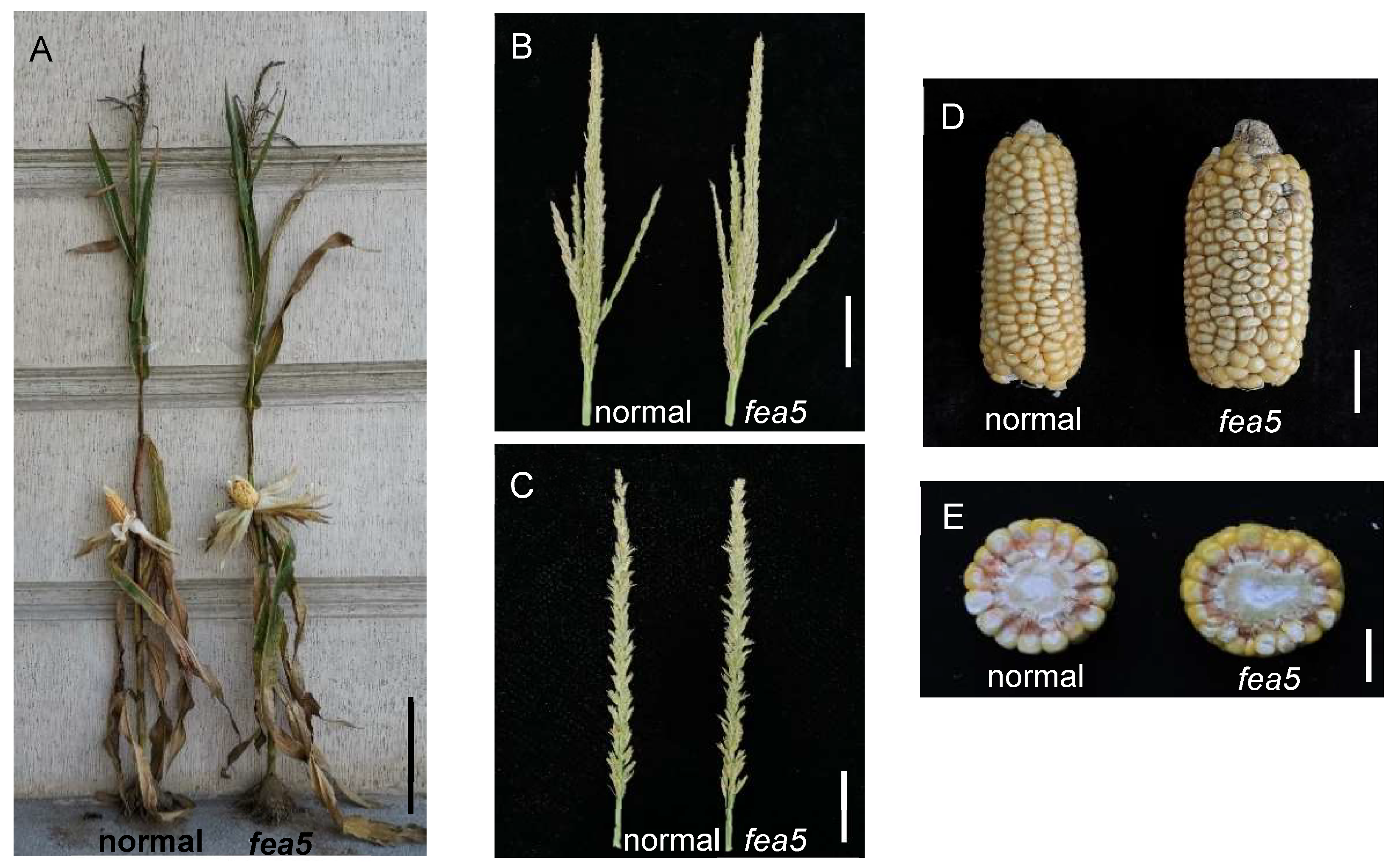
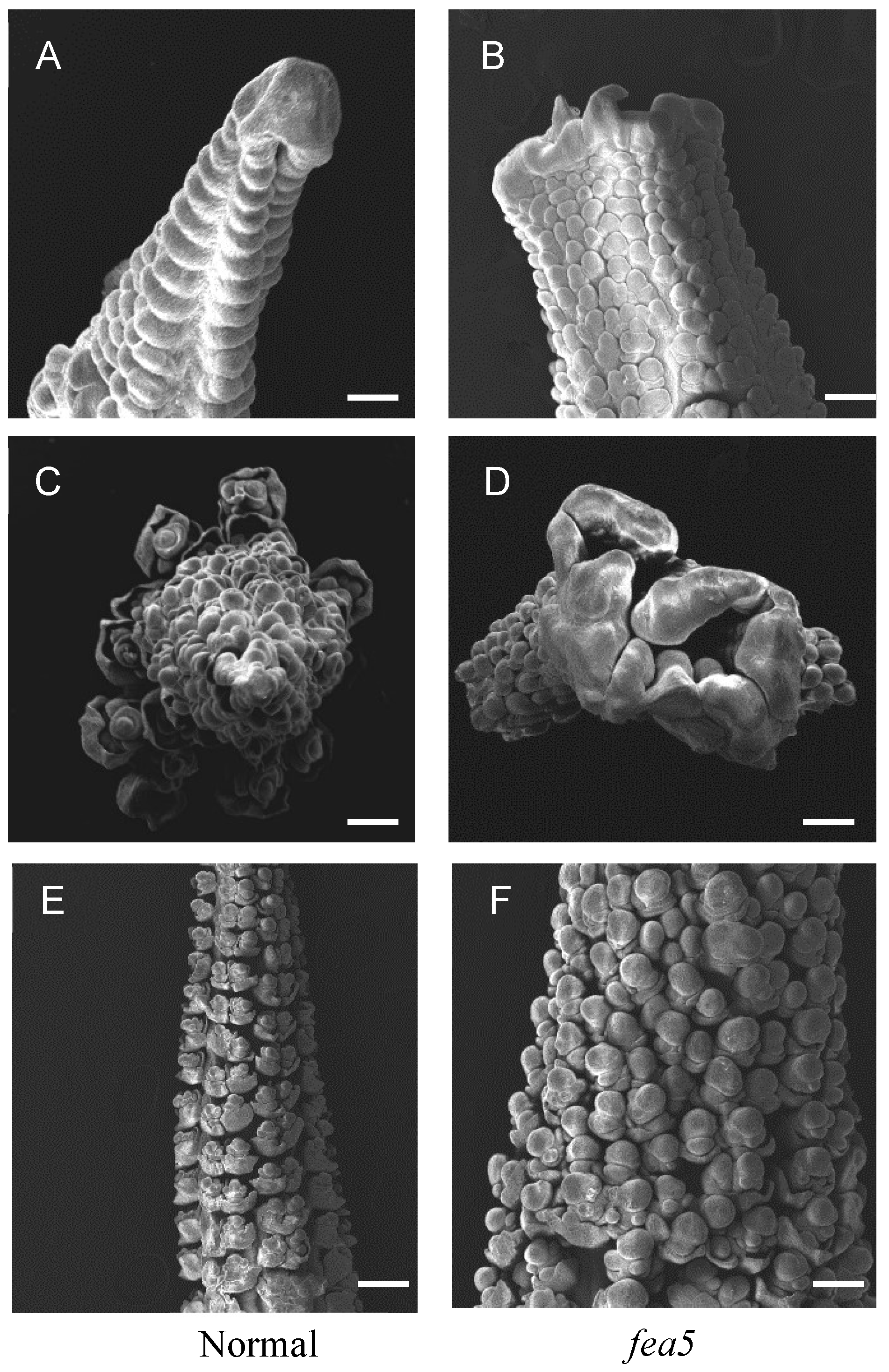
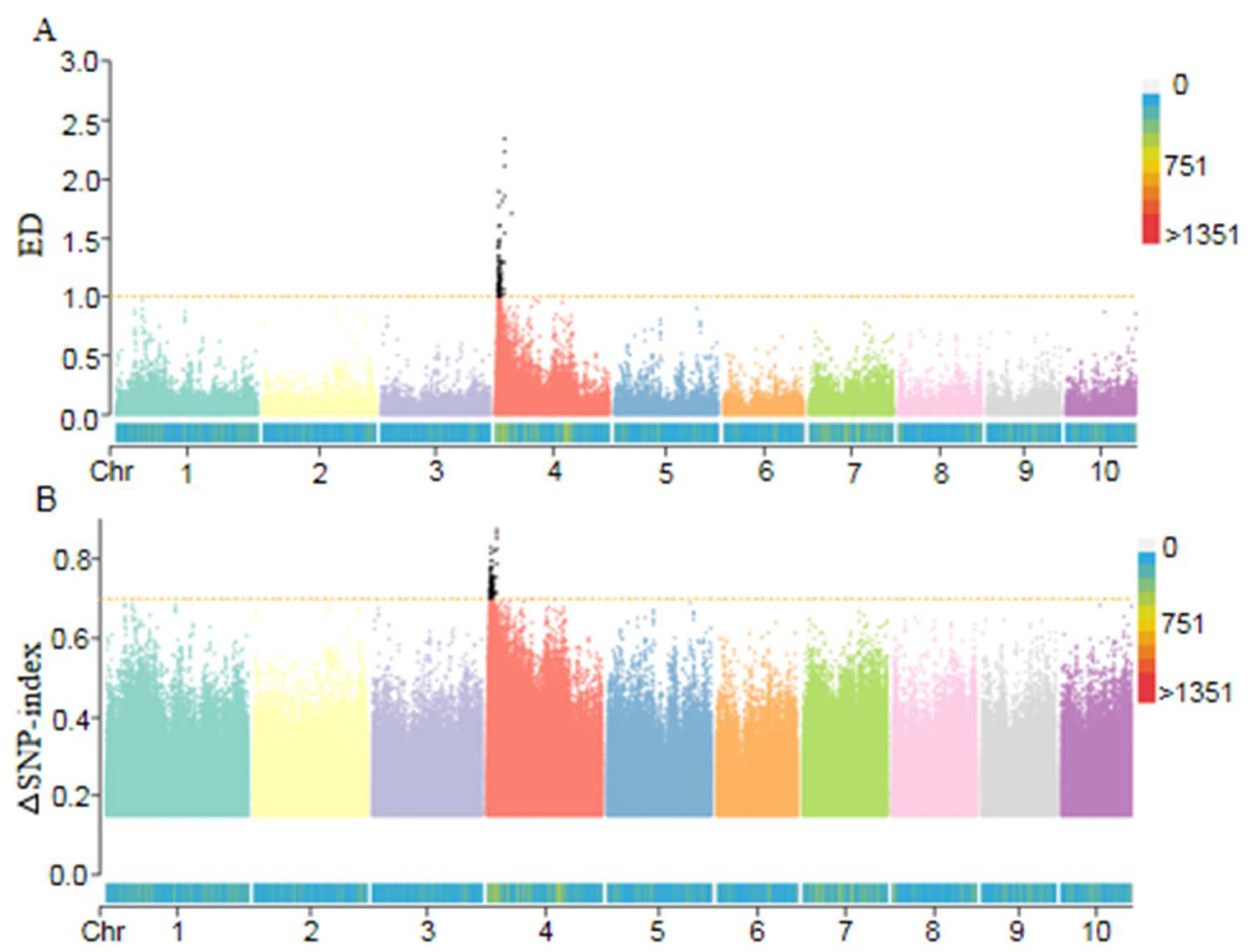

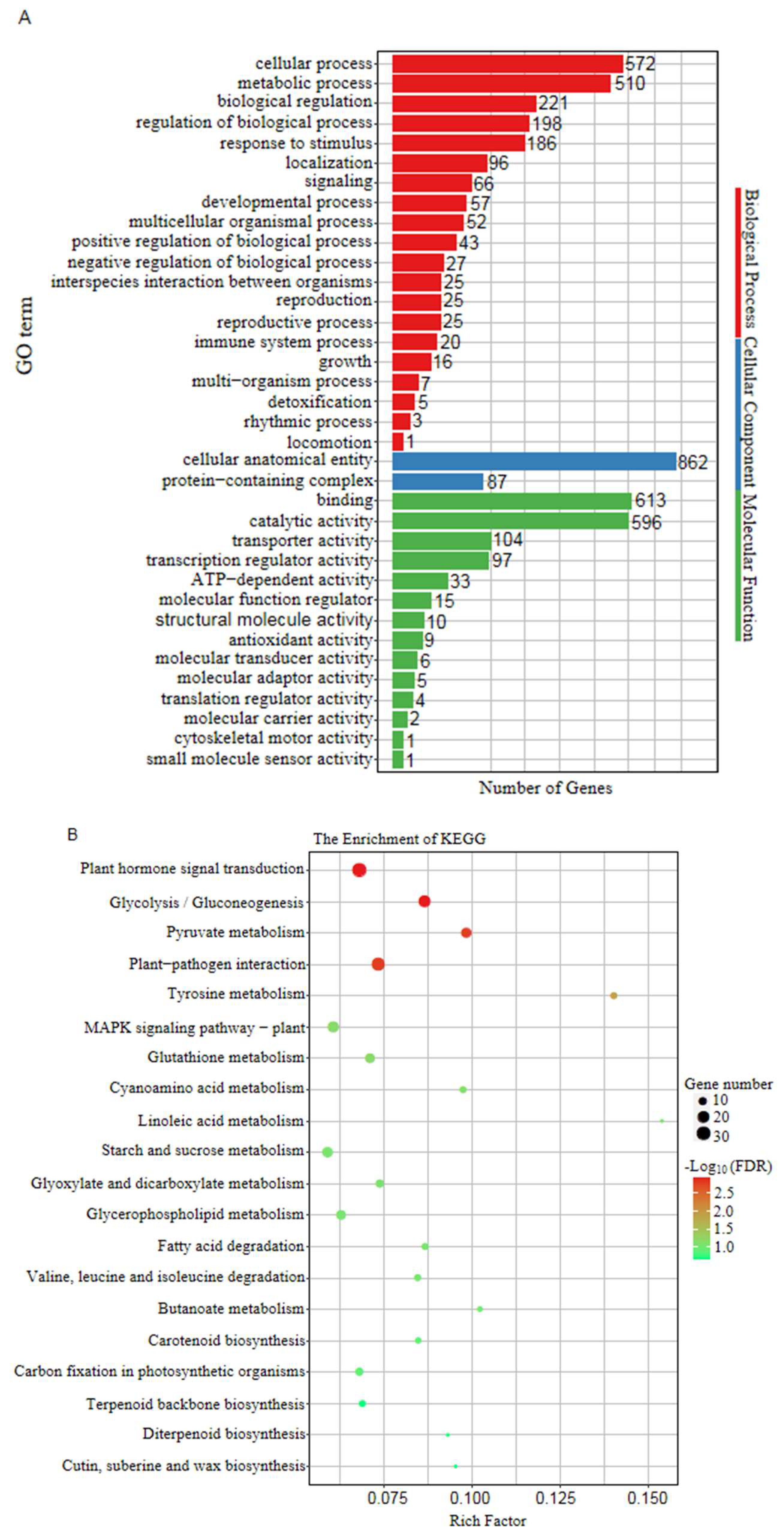
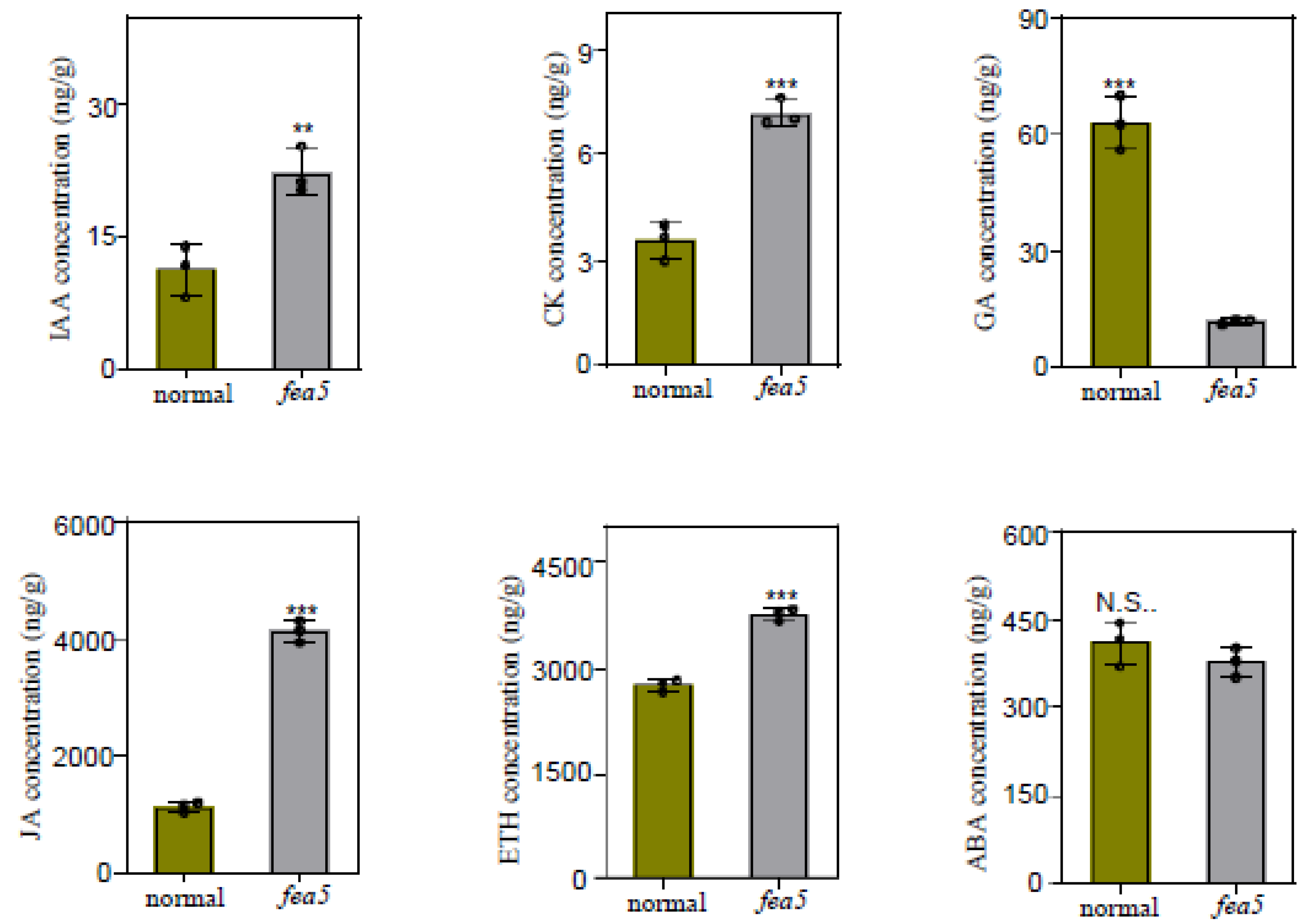
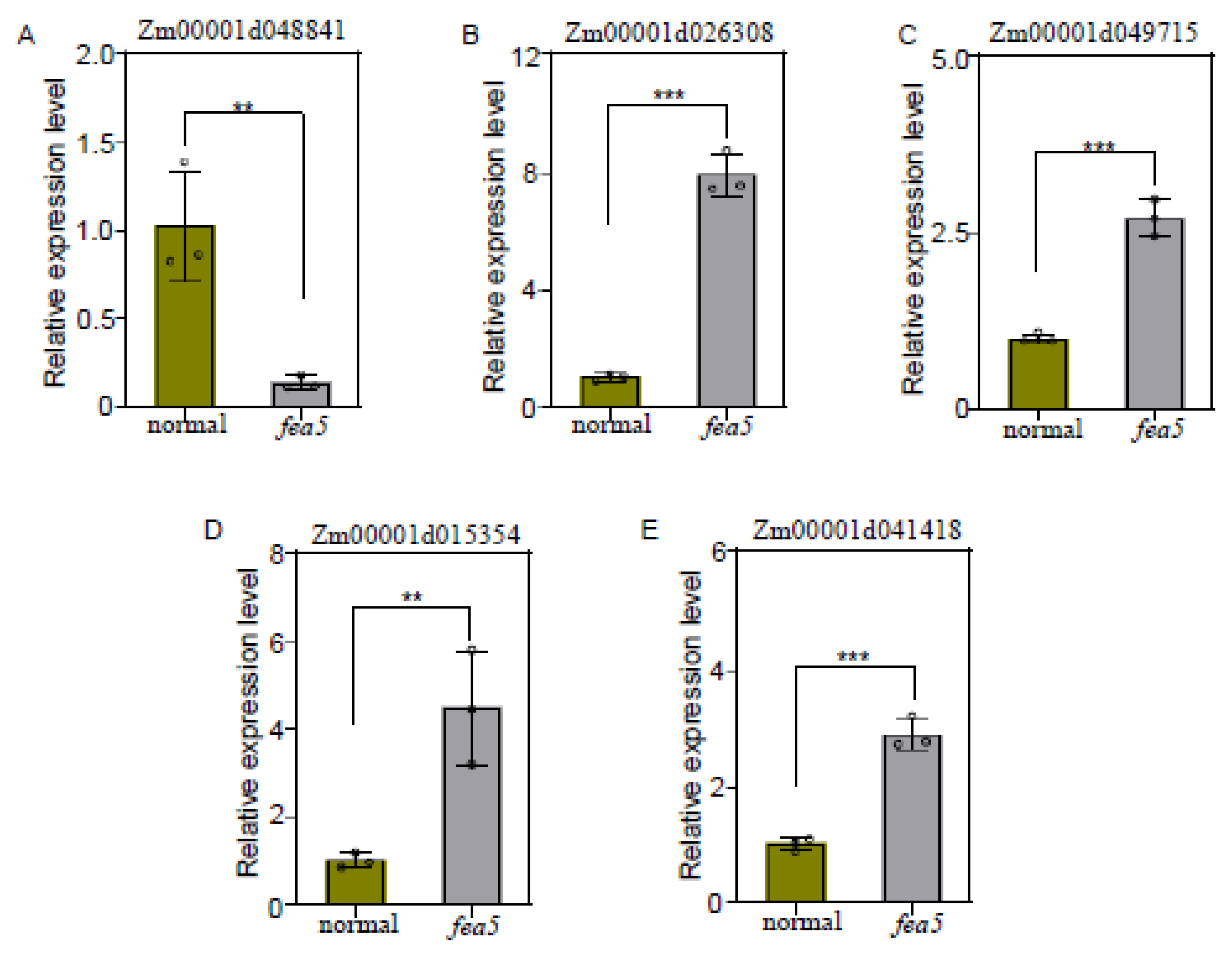
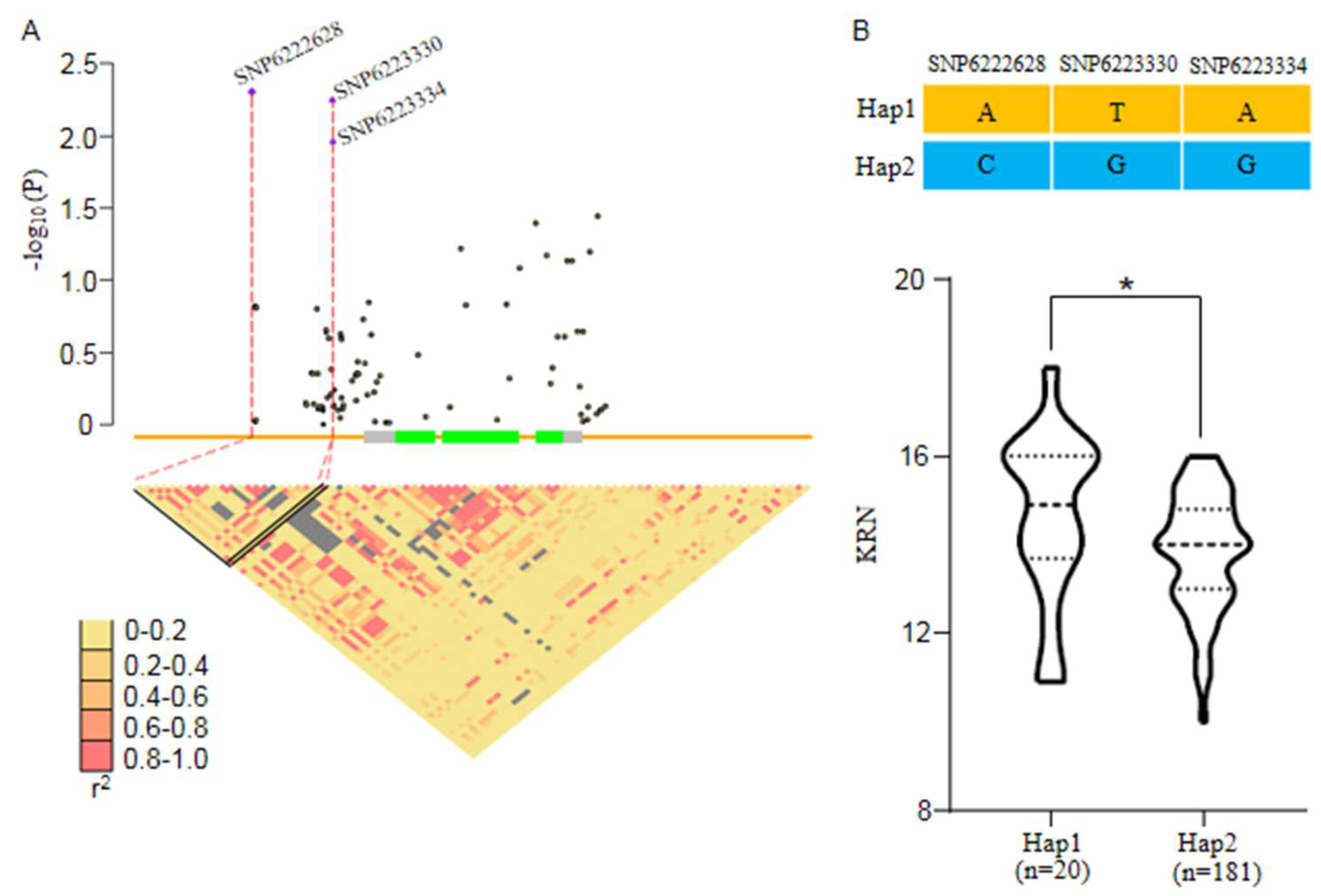
| Trait | n | Normal | fea5 |
|---|---|---|---|
| Sanya | |||
| Plant height (cm) | 40 | 181.2 ± 9.3 | 182.7 ± 8.5 |
| Ear height (cm) | 40 | 82.5 ± 5.5 | 81.0 ± 9.1 |
| Number of maize leaves | 40 | 9.9 ± 0.9 | 9.53 ± 0.64 |
| Stem diameter (mm) | 40 | 17.56 ± 1.82 | 17.85 ± 1.49 |
| Tassel branch number | 40 | 9.3 ± 1.6 | 8.8 ± 1.88 |
| Ear diameter (mm) | 40 | 36.2 ± 3.0 | 53.9 ± 2.9 *** |
| Ear length (mm) | 40 | 110.1 ± 11.4 | 105.7 ± 14.8 |
| Ear kernel weight (g) | 40 | 75.25 ± 5.29 | 80.25 ± 3.56 ** |
| Zhengzhou | |||
| Plant height (cm) | 40 | 186.0 ± 5.2 | 187.3 ± 8.4 |
| Ear height (cm) | 40 | 88.5 ± 4.0 | 87.2 ± 4.0 |
| Number of maize leaves | 40 | 10.8 ± 0.8 | 10.6 ± 1.5 |
| Stem diameter (mm) | 40 | 19.9 ± 2.5 | 18.9 ± 1.9 |
| Tassel branch number | 40 | 9.1 ± 1.0 | 8.9 ± 1.3 |
| Ear diameter (mm) | 40 | 37.1 ± 1.7 | 54.8 ± 1.6 *** |
| Ear length (mm) | 40 | 121.0 ± 9.2 | 118.3 ± 16.2 |
| Ear kernel weight (g) | 40 | 78.25 ± 4.36 | 81.25 ± 2.78 * |
| Asterisks indicate significant differences: * p < 0.05, ** p < 0.01, *** p < 0.001. | |||
| Plant Hormone Signal Transduction | Gene ID | Normal-FPKM | fea5-FPKM | logFC | FDR | Description |
|---|---|---|---|---|---|---|
| ABA signal transduction | Zm00001d018178 | 6.31 | 23.28 | 1.97 | 1.81 × 10−4 | ABSCISIC ACID-INSENSITIVE 5-like protein 5 |
| Zm00001d042721 | 15.53 | 44.24 | 1.60 | 8.36 × 10−5 | G-box-binding factor 4 | |
| Zm00001d020938 | 1.15 | 0.30 | −1.82 | 4.26 × 10−2 | bZIP transcription factor family protein | |
| Zm00001d047220 | 58.29 | 23.03 | −1.26 | 5.44 × 10−5 | Serine/threonine-protein kinase SRK2C | |
| IAA signal transduction | Zm00001d030310 | 37.73 | 8.31 | −2.17 | 1.57 × 10−5 | auxin import carrier1 |
| Zm00001d013130 | 2.29 | 0.45 | −2.41 | 2.36 × 10−3 | Transcription factor PIF4 | |
| Zm00001d034298 | 8.34 | 3.66 | −1.11 | 2.54 × 10−3 | Transcription factor PIF4 | |
| Zm00001d008749 | 44.85 | 9.46 | −2.13 | 7.64 × 10−10 | barren inflorescence1 | |
| Zm00001d049715 | 2.57 | 6.99 | 1.53 | 3.29 × 10−2 | IAA25-auxin-responsive Aux/IAA family member | |
| Zm00001d026308 | 0.84 | 24.62 | 4.89 | 5.26 × 10−5 | Auxin-responsive protein SAUR71 | |
| Zm00001d015354 | 5.71 | 29.55 | 2.49 | 4.65 × 10−3 | Auxin-responsive protein SAUR71 | |
| Zm00001d041418 | 2.47 | 12.93 | 2.49 | 1.76 × 10−7 | Auxin-responsive protein IAA4 | |
| CK signal transduction | Zm00001d018380 | 35.94 | 16.49 | −1.02 | 2.94 × 10−4 | Two-component response regulator ARR12 |
| Zm00001d033786 | 28.65 | 9.59 | −1.48 | 1.06 × 10−11 | histidine kinase4 | |
| ETH signal transduction | Zm00001d031445 | 4.82 | 2.00 | −1.15 | 4.42 × 10−3 | ETHYLENE INSENSITIVE 3-like 3 protein |
| Zm00001d003451 | 11.63 | 0.15 | −7.90 | 2.58 × 10−15 | ETHYLENE INSENSITIVE 3-like 5 protein | |
| Zm00001d053642 | 58.61 | 15.63 | −1.77 | 1.75 × 10−3 | EIN3-binding F-box protein 1 | |
| Zm00001d000408 | 39.65 | 10.01 | −1.73 | 2.92 × 10−3 | EIN3-binding F-box protein 1 | |
| Zm00001d036880 | 76.05 | 17.43 | −1.99 | 1.75 × 10−6 | EIN3-binding F-box protein 1 | |
| GA signal transduction | Zm00001d052126 | 3.46 | 1.04 | −2.11 | 1.31 × 10−2 | SLR1 |
| Zm00001d002410 | 159.47 | 455.45 | 1.57 | 1.42 × 10−2 | Probable xyloglucan endotransglucosylase/hydrolase protein 21 | |
| JA signal transduction | Zm00001d027900 | 4.58 | 42.21 | 3.22 | 8.84 × 10−4 | Protein TIFY 10B |
| Zm00001d014253 | 35.24 | 199.52 | 2.39 | 8.32 × 10−4 | ZIM motif family protein | |
| Zm00001d042833 | 83.14 | 35.50 | −1.13 | 5.52 × 10−4 | Coronatine-insensitive protein 1 | |
| Zm00001d033049 | 5.66 | 63.32 | 3.47 | 4.48 × 10−3 | ZIM motif family protein | |
| Zm00001d011377 | 9.69 | 3.75 | −1.22 | 1.77 × 10−3 | Jasmonic acid-amido synthetase JAR1 | |
| Zm00001d034944 | 7.29 | 15.10 | 1.15 | 3.25 × 10−4 | Regulatory protein NPR3 | |
| Zm00001d014249 | 1.19 | 12.02 | 3.37 | 8.63 × 10−4 | ZIM-transcription factor 29 | |
| Zm00001d034536 | 34.87 | 130.87 | 1.88 | 3.62 × 10−2 | Protein TIFY 10B | |
| Zm00001d020614 | 20.72 | 118.89 | 2.55 | 3.29 × 10−4 | ZIM-transcription factor 28 | |
| Zm00001d033050 | 30.08 | 235.53 | 2.98 | 2.46 × 10−4 | ZIM motif family protein | |
| Zm00001d047017 | 11.78 | 33.06 | 1.56 | 1.68 × 10−2 | Putative HLH DNA-binding domain superfamily protein |
Disclaimer/Publisher’s Note: The statements, opinions and data contained in all publications are solely those of the individual author(s) and contributor(s) and not of MDPI and/or the editor(s). MDPI and/or the editor(s) disclaim responsibility for any injury to people or property resulting from any ideas, methods, instructions or products referred to in the content. |
© 2023 by the authors. Licensee MDPI, Basel, Switzerland. This article is an open access article distributed under the terms and conditions of the Creative Commons Attribution (CC BY) license (https://creativecommons.org/licenses/by/4.0/).
Share and Cite
Yan, P.; Li, W.; Zhou, E.; Xing, Y.; Li, B.; Liu, J.; Zhang, Z.; Ding, D.; Fu, Z.; Xie, H.; et al. Integrating BSA-Seq with RNA-Seq Reveals a Novel Fasciated Ear5 Mutant in Maize. Int. J. Mol. Sci. 2023, 24, 1182. https://doi.org/10.3390/ijms24021182
Yan P, Li W, Zhou E, Xing Y, Li B, Liu J, Zhang Z, Ding D, Fu Z, Xie H, et al. Integrating BSA-Seq with RNA-Seq Reveals a Novel Fasciated Ear5 Mutant in Maize. International Journal of Molecular Sciences. 2023; 24(2):1182. https://doi.org/10.3390/ijms24021182
Chicago/Turabian StyleYan, Pengshuai, Weihua Li, Enxiang Zhou, Ye Xing, Bing Li, Jing Liu, Zhanhui Zhang, Dong Ding, Zhiyuan Fu, Huiling Xie, and et al. 2023. "Integrating BSA-Seq with RNA-Seq Reveals a Novel Fasciated Ear5 Mutant in Maize" International Journal of Molecular Sciences 24, no. 2: 1182. https://doi.org/10.3390/ijms24021182
APA StyleYan, P., Li, W., Zhou, E., Xing, Y., Li, B., Liu, J., Zhang, Z., Ding, D., Fu, Z., Xie, H., & Tang, J. (2023). Integrating BSA-Seq with RNA-Seq Reveals a Novel Fasciated Ear5 Mutant in Maize. International Journal of Molecular Sciences, 24(2), 1182. https://doi.org/10.3390/ijms24021182





